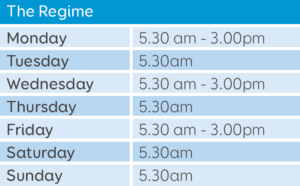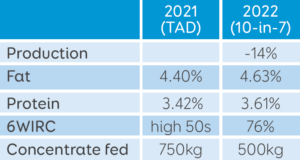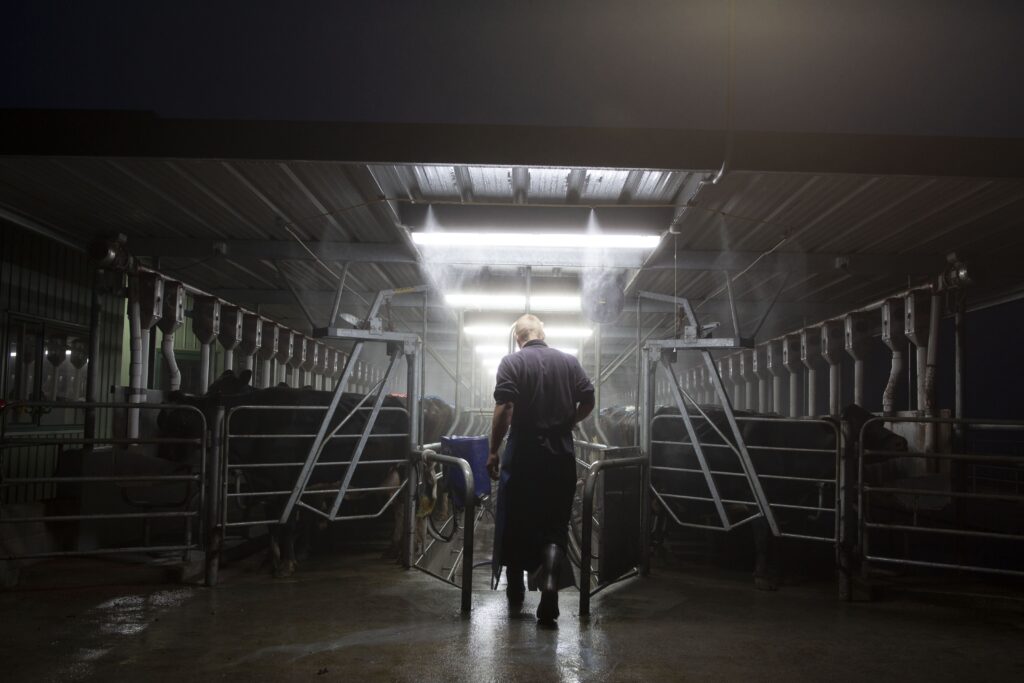With staff shortages, and a work/life balance becoming more important, more and more UK farmers are looking at the possibility of changing milking frequencies.
While some remain sceptical about a loss in production, there is great opportunity to gain in other areas of the business such as fertility and cow health, staffing costs and savings in energy costs.
 In the summer of 2022, we checked in with James Rowntree who farms 200 spring calving cows in North Yorkshire. He was mid-way through a full season on a 10-in-7 milking regime on the way to eventually implementing a once-a-day system.
In the summer of 2022, we checked in with James Rowntree who farms 200 spring calving cows in North Yorkshire. He was mid-way through a full season on a 10-in-7 milking regime on the way to eventually implementing a once-a-day system.
Results at the time were positive with submission rates up 5%, reduced lameness, better body condition and significant energy savings. But now the 2022 season has come to an end, what is James’ final verdict?
What have been the main benefits for you going 10-in-7?
Opening up land which we have never grazed with cows before, simply because on those once-a-day milking days it has allowed us to walk them a lot further, we have access to a lot more ground, which last year was ideal because it was quite a dry summer.
What differences, if any, have you noticed in production?
Volume decreased by 14% over the season, fat was running at 4.4% average and went up to 4.63%. Protein averaged 3.42% and it moved up to 3.61%
How has it impacted cow health and fertility?
We were moving the two blocks into the one, and it definitely allowed us to tighten that block up quicker, we actually brought the autumn calvers round rather than selling them and buying in spring. We culled anything that didn’t get in calf and kept those ones that got back in calf, so we ended up with a six-week in-calf rate (6WICR) of 76% and that was our first time bringing them round to spring so I was really happy with that.
They put on weight, that was probably the only problem, our cows are quite fat anyway, so they were probably putting on too much condition. It’s probably the only thing that I would have complained about, but it allowed us to work them harder, and they did get fed 500kg of concentrate the whole season so we dropped it quite substantially and made them work off grass a lot more.
How did you manage AI while running 10-in-7?
We just AI’d once a day, but if we had any queries about a cow we would serve them on an afternoon if it was a twice-a-day milking, but to be honest we did it just the once-a-day and didn’t have a problem.
Have you seen any cost savings?
We had a 22% drop in electricity usage, not turning on the parlour, not cooling the milk, not washing out. We also saved on foot trimming – we had less feet to do. The cake usage was down too, we fed about 750kg previously, obviously with the increase in cake costs, this saved us a lot as well. Chemical savings, washing the parlour less – there are lots of things that you don’t realise you will save money on.
What has been the impact on farm with less time in the shed?
Catching up on jobs that either we would have had to bring a contractor in for or we just wouldn’t have had time to do.
What regime are you following this season and why?
We started off milking twice a day because the price of milk was so high, and the weather was so poor in March, that we couldn’t get the cows back out. Once they went out we went onto fully once-a-day [which has always been the long-term plan for James], the reason for that is the milk price has come back so much and we are going to be heavily penalised on B price.
Why was it always on the cards to go OAD?
I think staffing is a big thing, there are a lot of farms around here so I think if we were ever looking for more staff, it would make us look more attractive for potential employees.
With us having a main road through the farm, we can access the ground on twice-a-day, but bringing them across the road for the afternoon milking was pretty bad, and you have to have two people on the road plus one bringing them in, and sometimes we didn’t have that option so it’s just making it safer and more accessible with milking once a day.
 Production reduced going 10-in-7 for James, however, it is clear to see the savings and gains in animal health have off-set the loss, all the while improving their labour efficiency and work/life balance. While it was always a phase of transition to once-a-day, it has worked in their favour and has highlighted the possibility of 10-in-7 being viable as a permanent milking regime.
Production reduced going 10-in-7 for James, however, it is clear to see the savings and gains in animal health have off-set the loss, all the while improving their labour efficiency and work/life balance. While it was always a phase of transition to once-a-day, it has worked in their favour and has highlighted the possibility of 10-in-7 being viable as a permanent milking regime.


